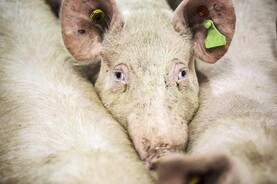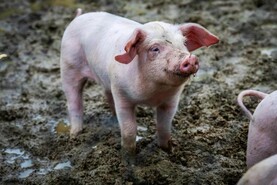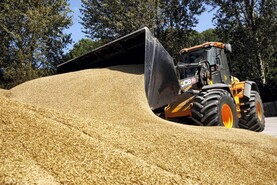Pig HealthCheck (PHC) is an Animal Health Ireland (AHI)-led programme co-funded by pig producers and the Department of Agriculture, designed to improve the profitability and sustainability of the sector through improved animal health and welfare. It comprises five components:
Biosecurity: assessments funded through the Targeted Advisory Service on Animal Health (TASAH) under the Rural Development Programme.Animal Welfare: assessments funded through the TASAH.Animal health: display of factory AM/PM data (currently only ante mortem).Salmonella: display of the salmonella serology score and the salmonella TASAH activity.Antimicrobial usage: display of data inputted by farmers into the Department’s AMU pig database.By bringing together these five key areas at farm level, the programme provides valuable information to the farmer, his/her veterinary practitioner and advisers that can be used to identify areas requiring improvement and guide agreement on targeted interventions.
Ultimately, coupled with benchmarking, this will help farmers to improve their production performance.
To achieve this, a database has been created that allows all data captured from the five programme components to be linked and analysed.
A series of dashboards for each component display farm data and benchmark this against other herds and national averages.
These are displayed in the PHC web application, which is accessible at https://www.pighealthcheck.ie or through the AHI website. This PHC web application is there for pig farmers to use. Please do so.
Benchmarking is always a good exercise. This is a measuring tool to indicate when appropriate action is needed.
Access for each individual farmer is password-protected. Individual farm data is also accessible to the attending private veterinary practitioner (PVP) nominated by the farmer using the Pig Herd Update Form (Option 4).
It is essential that each farm has a nominated PVP as this is a requirement to perform the herd’s TASAH assessments.
The AHI website has videos and guides for farmers on how to access and understand their data.
Bord Bia, in September 2021, updated its pig quality assurance standard to include a requirement for these farm biosecurity and animal welfare risk assessments to be carried out annually, along with the quarterly submission of AMU data to the Department’s database.
Good biosecurity is essential to keep disease out of herds and with the current situation with African swine fever in Europe there is a renewed focus on biosecurity.
The farm biosecurity assessments are done using the BiocheckUGent tool and delivered by PVPs.
All measures taken to counteract the spread of pathogens within a farm are covered by internal biosecurity
In this tool a distinction is made between external and internal biosecurity. External biosecurity focuses on the contact points with the outside world and aims to prevent pathogens from entering or leaving the farm.
All measures taken to counteract the spread of pathogens within a farm are covered by internal biosecurity.
As of the end of September 2023, 384 units have been reviewed in terms of their biosecurity, with external biosecurity scoring higher (average of 82% in a score from 0% – poor to 100% – excellent) than internal biosecurity (average of 67%).
The areas where scores are typically lower (ie poorer biosecurity) are:
Management of feed, water and equipment coming on to farms (eg water quality, cleaning and disinfecting material before it is introduced). Measures implemented between compartments and the use of equipment within the farm (eg house-specific clothing and footwear, use of footbaths). Cleaning and disinfection procedures (eg for pens after each production cycle).Measures focusing on the farrowing unit and suckling period (eg washing sows before entering the farrowing room, avoiding cross-fostering).Of the 384 units assessed, 149 units have done at least three biosecurity assessments, with results showing an overall improvement in their internal, external and overall biosecurity scores between visits.
The current serological test for salmonella, using factory-collected samples, does not identify the strains of salmonella that may be present on farm.
There are many strains of salmonella that can affect human health but the serious serotypes, Salmonella Typhimurium (ST) and monophasic Salmonella Typhimurium (mST) are the two mostly associated with the consumption of pigmeat and are also the most problematic serotypes on pig farms where they are easily transmitted between pigs and humans.
A further issue is that many ST and mST strains display multiple drug resistance (ie they are resistant to at least three antibiotics).
Knowing the strain of salmonella present helps formulate a suitable “on farm control programme”.
Consequently, a funded TASAH has been created in the form of on-farm bacteriological tests that can identify the strains of salmonella specific to the farm, if it is present.
This Department-funded TASAH activity is free of charge and covers the bacteriological testing of faecal samples collected by the nominated PVP.
Agreed measures may include vaccination, specific hygiene programmes, external and internal biosecurity measures
Test results are confidential and remain between the farmer, the PVP and AHI, who manage the programme database and will be used to develop “farm-specific” control plans for salmonella which is drawn up by the PVP in agreement with the farmer in the same manner as dealing with other diseases present on the farm.
Agreed measures may include vaccination, specific hygiene programmes, external and internal biosecurity measures and other courses of action the PVP may suggest.
The implementation of this farm-specific control plan may come with additional costs.
However, these measures may also benefit the control of other diseases and the overall performance of the piggery.
Pig HealthCheck (PHC) is an Animal Health Ireland (AHI)-led programme co-funded by pig producers and the Department of Agriculture, designed to improve the profitability and sustainability of the sector through improved animal health and welfare. It comprises five components:
Biosecurity: assessments funded through the Targeted Advisory Service on Animal Health (TASAH) under the Rural Development Programme.Animal Welfare: assessments funded through the TASAH.Animal health: display of factory AM/PM data (currently only ante mortem).Salmonella: display of the salmonella serology score and the salmonella TASAH activity.Antimicrobial usage: display of data inputted by farmers into the Department’s AMU pig database.By bringing together these five key areas at farm level, the programme provides valuable information to the farmer, his/her veterinary practitioner and advisers that can be used to identify areas requiring improvement and guide agreement on targeted interventions.
Ultimately, coupled with benchmarking, this will help farmers to improve their production performance.
To achieve this, a database has been created that allows all data captured from the five programme components to be linked and analysed.
A series of dashboards for each component display farm data and benchmark this against other herds and national averages.
These are displayed in the PHC web application, which is accessible at https://www.pighealthcheck.ie or through the AHI website. This PHC web application is there for pig farmers to use. Please do so.
Benchmarking is always a good exercise. This is a measuring tool to indicate when appropriate action is needed.
Access for each individual farmer is password-protected. Individual farm data is also accessible to the attending private veterinary practitioner (PVP) nominated by the farmer using the Pig Herd Update Form (Option 4).
It is essential that each farm has a nominated PVP as this is a requirement to perform the herd’s TASAH assessments.
The AHI website has videos and guides for farmers on how to access and understand their data.
Bord Bia, in September 2021, updated its pig quality assurance standard to include a requirement for these farm biosecurity and animal welfare risk assessments to be carried out annually, along with the quarterly submission of AMU data to the Department’s database.
Good biosecurity is essential to keep disease out of herds and with the current situation with African swine fever in Europe there is a renewed focus on biosecurity.
The farm biosecurity assessments are done using the BiocheckUGent tool and delivered by PVPs.
All measures taken to counteract the spread of pathogens within a farm are covered by internal biosecurity
In this tool a distinction is made between external and internal biosecurity. External biosecurity focuses on the contact points with the outside world and aims to prevent pathogens from entering or leaving the farm.
All measures taken to counteract the spread of pathogens within a farm are covered by internal biosecurity.
As of the end of September 2023, 384 units have been reviewed in terms of their biosecurity, with external biosecurity scoring higher (average of 82% in a score from 0% – poor to 100% – excellent) than internal biosecurity (average of 67%).
The areas where scores are typically lower (ie poorer biosecurity) are:
Management of feed, water and equipment coming on to farms (eg water quality, cleaning and disinfecting material before it is introduced). Measures implemented between compartments and the use of equipment within the farm (eg house-specific clothing and footwear, use of footbaths). Cleaning and disinfection procedures (eg for pens after each production cycle).Measures focusing on the farrowing unit and suckling period (eg washing sows before entering the farrowing room, avoiding cross-fostering).Of the 384 units assessed, 149 units have done at least three biosecurity assessments, with results showing an overall improvement in their internal, external and overall biosecurity scores between visits.
The current serological test for salmonella, using factory-collected samples, does not identify the strains of salmonella that may be present on farm.
There are many strains of salmonella that can affect human health but the serious serotypes, Salmonella Typhimurium (ST) and monophasic Salmonella Typhimurium (mST) are the two mostly associated with the consumption of pigmeat and are also the most problematic serotypes on pig farms where they are easily transmitted between pigs and humans.
A further issue is that many ST and mST strains display multiple drug resistance (ie they are resistant to at least three antibiotics).
Knowing the strain of salmonella present helps formulate a suitable “on farm control programme”.
Consequently, a funded TASAH has been created in the form of on-farm bacteriological tests that can identify the strains of salmonella specific to the farm, if it is present.
This Department-funded TASAH activity is free of charge and covers the bacteriological testing of faecal samples collected by the nominated PVP.
Agreed measures may include vaccination, specific hygiene programmes, external and internal biosecurity measures
Test results are confidential and remain between the farmer, the PVP and AHI, who manage the programme database and will be used to develop “farm-specific” control plans for salmonella which is drawn up by the PVP in agreement with the farmer in the same manner as dealing with other diseases present on the farm.
Agreed measures may include vaccination, specific hygiene programmes, external and internal biosecurity measures and other courses of action the PVP may suggest.
The implementation of this farm-specific control plan may come with additional costs.
However, these measures may also benefit the control of other diseases and the overall performance of the piggery.






 This is a subscriber-only article
This is a subscriber-only article










SHARING OPTIONS: